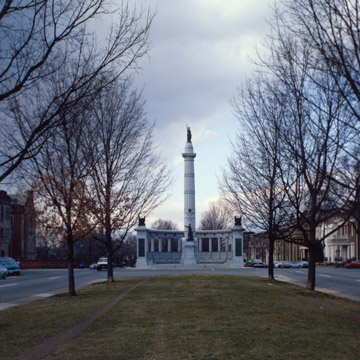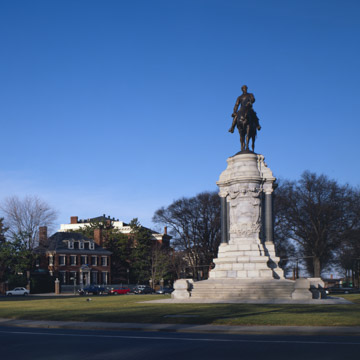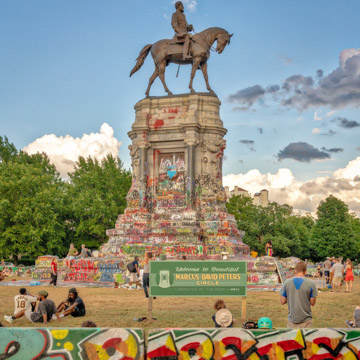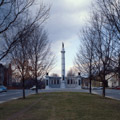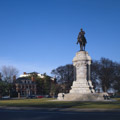Monument Avenue exemplifies the complex history of Virginia, and Richmond in particular, in its connection to slavery, the Civil War, and decades of de jure and de facto segregation in the public realm. When originally laid out Monument Avenue was a grand thoroughfare in the tradition of earlier boulevards in Europe and America, 140-feet wide, divided by a grassy median, and lined with trees. The historic section of Monument Avenue stretches out from the old city limits at Franklin Street for one and one-half miles. It was planned with a dual purpose. Proposed in 1887 to provide an appropriate setting for a major memorial to General Robert E. Lee, the Avenue was also intended to encourage residential development west of the city. Ironically, Richmonders saw the combination of memorial statues to the so-called Lost Cause and a beautiful new boulevard as an attempt to establish themselves as leaders of the New South. The story portrayed by the statues made no mention of slavery, treason, or white supremacy, and indeed it looked like an avenue of victors, rather than losers. Unironically, restrictive covenants preventing the sale of houses “to any person of African descent” were in place from the very beginning of the development.
The Avenue’s plan was laid out by a Richmond engineer, C. P. E. Burgwyn, who had studied at Harvard and was certainly familiar with Boston's earlier grand boulevard, Commonwealth Avenue. The broad, tree-lined avenue inspired prominent white citizens to erect a remarkably coherent collection of large town houses and apartment buildings, which are a catalog of early-twentieth-century architectural styles. Although the Avenue developed slowly and without consistent design covenants, a general compatibility in materials, cornices, rooflines, orientation, and setback helped link the blocks together. The western march of residential development was matched by a series of commemorative sculptures, all related to the Confederacy until 1996.
The historic district reaches from St. James's Episcopal Church, one block from the end of Franklin Street, to the intersection of Roseneath Road, site of a later addition to the street's sculpture, the Arthur Ashe Monument. Moving westward from Stuart Circle, where the easternmost statue was located, to Roseneath Road gives a sense of the chronological development of the street. Franklin Street traffic originally ran both ways, and the passage from the narrow, tree-darkened older street into the new, bright avenue must have been startling. Beginning at its eastern end, Monument Avenue was built up sporadically, but always reaching farther west. Residences in the first two blocks, which date from c. 1900, include some examples of the Queen Anne and Richardsonian Romanesque styles, but from the former site of the Lee Monument onward, the Colonial Revival style dominates the streetscape. Likewise, the street, which begins with a dense, vertical display of town houses, gradually includes mansions and then apartment buildings, and finally becomes more suburban in feeling, with more modest, horizontal houses set back farther from the street and from each other than the earlier buildings.
The Avenue and its Confederate statues have been the subject of a decades-long debate over their appropriateness, but recent protests, sparked by the murder of George Floyd in May 2020 and fueled by the subsequent anti-racism protests, finally led to the removal of four of the five statues in June and July of 2020; the fifth statue, of Robert E. Lee, which was located on state property, followed in September 2021. The pedestals were scheduled for removal in early 2022. The only statue that remains on Monument Avenue is of tennis legend Arthur Ashe, installed in 1996 to great controversy. Another powerful rebuke to the Confederate monuments is located nearby on Arthur Ashe Boulevard: Kehinde Wiley’s Rumors of War (2019). What, if anything, will replace the Confederate statues is unknown; it is also likely that Monument Avenue will be renamed. The removed statues will be given to Richmond's Black History Museum and Culture Center.
Note: There are no blocks numbered 1700, 1900, 2100, or 2400.
References
Driggs, Sarah Shields, Richard Guy Wilson, and Robert P. Winthrop. Richmond's Monument Avenue. Chapel Hill: University of North Carolina Press, 2001.
Levin, Kevin M. “Richmond’s Confederate Monuments Were Used to Sell a Segregated Neighborhood.” The Atlantic, June 11, 2020.














